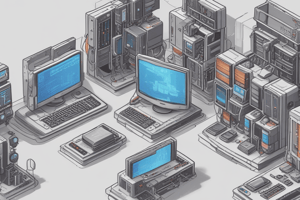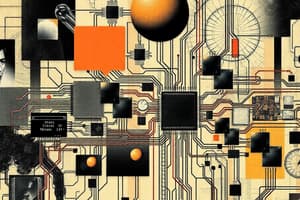Podcast
Questions and Answers
What is a fundamental characteristic that distinguishes real-time systems from other types of computing systems?
What is a fundamental characteristic that distinguishes real-time systems from other types of computing systems?
- They only utilize advanced hardware configurations.
- They primarily focus on user interface design.
- They are designed to maximize computational throughput without regard to latency.
- They are evaluated on both the logical correctness and the timeliness of their outputs. (correct)
In the context of real-time systems, what does 'response time' specifically refer to?
In the context of real-time systems, what does 'response time' specifically refer to?
- The time elapsed between presenting inputs to a system and the availability of all associated outputs/required behavior. (correct)
- The rate at which a system can process user queries.
- The speed at which a processor executes individual instructions.
- The duration a system requires to boot up.
Why is scheduling analysis considered a crucial task in the early stages of real-time system development?
Why is scheduling analysis considered a crucial task in the early stages of real-time system development?
- To minimize the amount of memory used by the system.
- To allocate tasks in a way that critical timing properties of the system are formally verified. (correct)
- To select the programming language that is most suitable for writing real-time code.
- To ensure the system's user interface is intuitive and responsive.
What distinguishes real-time systems from interactive systems regarding delays?
What distinguishes real-time systems from interactive systems regarding delays?
How does the operational environment typically influence the task scheduling in reactive real-time systems?
How does the operational environment typically influence the task scheduling in reactive real-time systems?
What is a key characteristic of real-time systems regarding concurrent processing?
What is a key characteristic of real-time systems regarding concurrent processing?
What are the primary criteria used to classify real-time systems?
What are the primary criteria used to classify real-time systems?
What is a common challenge specifically associated with embedded real-time systems?
What is a common challenge specifically associated with embedded real-time systems?
What are the defining characteristics of distributed systems?
What are the defining characteristics of distributed systems?
What is the potential consequence of missing even a single deadline in a Hard Real-Time System?
What is the potential consequence of missing even a single deadline in a Hard Real-Time System?
In a Soft Real-Time System, what is the effect of occasionally missing deadlines?
In a Soft Real-Time System, what is the effect of occasionally missing deadlines?
What distinguishes a Firm Real-Time System from other types of real-time systems?
What distinguishes a Firm Real-Time System from other types of real-time systems?
What is true about practically defining the deadline of a real-time system?
What is true about practically defining the deadline of a real-time system?
Which task is essential for the functioning of a real-time system?
Which task is essential for the functioning of a real-time system?
Under transient overload in a real-time system, if it's impossible to meet all deadlines, what must still be guaranteed?
Under transient overload in a real-time system, if it's impossible to meet all deadlines, what must still be guaranteed?
Which is not an example of a real-time system application domain?
Which is not an example of a real-time system application domain?
Which is an example of real-time system application domains?
Which is an example of real-time system application domains?
In which of the following Real-Time System Application Domains is piloting an airplane?
In which of the following Real-Time System Application Domains is piloting an airplane?
In which of the following Real-Time System Application Domains is elevator control?
In which of the following Real-Time System Application Domains is elevator control?
In which of the following Real-Time System Application Domains is robotic assembly line?
In which of the following Real-Time System Application Domains is robotic assembly line?
Flashcards
Real-Time System
Real-Time System
A system where correctness depends on both the logical result and the time at which the result is produced.
Response Time
Response Time
The time between input presentation and the realization of the required behavior, including all associated outputs.
Failed System
Failed System
A system that fails to meet one or more requirements specified in its system requirements specification.
Embedded Systems
Embedded Systems
Signup and view all the flashcards
Hard Real-Time System
Hard Real-Time System
Signup and view all the flashcards
Soft Real-Time System
Soft Real-Time System
Signup and view all the flashcards
Firm Real-Time System
Firm Real-Time System
Signup and view all the flashcards
Embedded Systems (definition)
Embedded Systems (definition)
Signup and view all the flashcards
Real-Time Control
Real-Time Control
Signup and view all the flashcards
Reactive Systems
Reactive Systems
Signup and view all the flashcards
Concurrent Processing
Concurrent Processing
Signup and view all the flashcards
Study Notes
- SENG408 is a course on the Analysis, Design, and Modelling of Real-Time Systems.
- "Life will not give you what you desire, life will give you what you demand" - Anonymous
Course Outline
- Real-Time System (RTS) Fundamentals
- Hardware for Real-Time Systems
- Real-Time Operating Systems
- Requirement Engineering Methodologies of Embedded RTS
- Software Design Approaches for Embedded RTS
- Tools for Embedded RTS
- Performance Analysis Techniques
Fundamentals of Real-Time Systems
- Definitions of Real-Time System
- Characteristics of Real-Time Systems
- Types of Real-Time Systems
- Applications of Real-Time Embedded Systems
Definitions of Real-Time System
- Defined as systems where correctness depends on both the logical result and the time the result is produced.
- A real-time computing system is a system where the correctness of a computation depends on how it is done and when it's done.
- Logical correctness is based on the correctness of outputs and their timeliness.
- Complexity ranges from simple microcontrollers in automobile cruise control to complex distributed systems like air traffic control.
- Aircraft use accelerometer pulses to determine position, and other systems respond to non-regular events (e.g., overtemperature failure in a nuclear power plant).
- Modern telecommunication systems, automated factories, defense systems, power plants, aircraft, airports, spacecraft, medical instrumentation, supervisory control, data acquisition, people movers, and railroad switching cannot operate without real-time systems.
- A real-time system must satisfy bounded response time constraints to avoid severe consequences.
- A failed system cannot satisfy system requirements.
- Response time is the time between inputs and the availability of associated outputs.
- A real-time system should have predictable fast response to urgent events, high degree of schedulability, and stability under transient overload.
- Early development involves specific tasks like scheduling analysis, performance evaluation, and formal verification of critical timing properties.
Characteristics of Real-Time Systems
- Embedded systems consist of special-purpose computer-based information processing systems performing pre-defined tasks.
- Real-time systems have timing constraints specified in software requirements, where delays can be catastrophic.
- Real-time systems make control decisions based on input data without human intervention.
- Reactive systems are driven by ongoing interaction with their environment.
- Concurrent Processing: Many events need to be processed in parallel with potentially unpredictable order and variable input load.
Types of Real-Time System
- Classified based on hardware platform and deadline.
- There are two major categories of RTS based on hardware platform
- Embedded systems are computer systems for specific control functions, embedded in a larger device with hardware and mechanical parts, which makes updating difficult when failures are discovered.
- Distributed systems consist of autonomous computers connected to coordinate activities and share resources, and are required for dependability, physical constraints, and efficiency, but issues include heterogeneity, timing behavior, and resource management.
- Categorized based on deadline are Hard, Soft and Firm
- Hard Real-Time System: Missing a single deadline may lead to complete or catastrophic system failure
- Soft Real-Time System: Performance is degraded but not destroyed by failure to meet response-time constraints.
- Firm Real-Time System: Missing a few deadlines will not lead to total failure, but missing more than a few may lead to complete or catastrophic system failure.
- All practical systems are ultimately real-time systems.
- Deadlines are based on the underlying physical phenomena of the system under control.
- There are many soft deadlines and few hard deadlines and system designers must determine which deadlines are hard, and schedule processor time accordingly.
- Many utilize global clocks and time-stamping for synchronization, task initiation, and data marking.
Real-Time System Application Domains
- Telecommunication systems
- Automotive control
- Multimedia servers and workstations
- Signal processing systems
- Radar systems
- Consumer electronics
- Process control
- Automated manufacturing systems
- Supervisory control and data acquisition (SCADA) systems
- Electrical utilities
- Semiconductor fabrication systems
- Defense systems
- Avionics
- Air traffic control
- Autonomous navigation systems
- Vehicle control systems
- Transportation and traffic control systems
- Satellite systems
- Aerospace (Flight control, Navigation, Pilot interface)
- Civilian (Automotive systems, Elevator control, Traffic light control)
- Industrial (Automated inspection, Robotic assembly line, Welding control)
- Medical monitors (Intensive care, Magnetic resonance imaging, Remote surgery)
- Multimedia (Console games, Home theaters, Simulators)
Studying That Suits You
Use AI to generate personalized quizzes and flashcards to suit your learning preferences.




